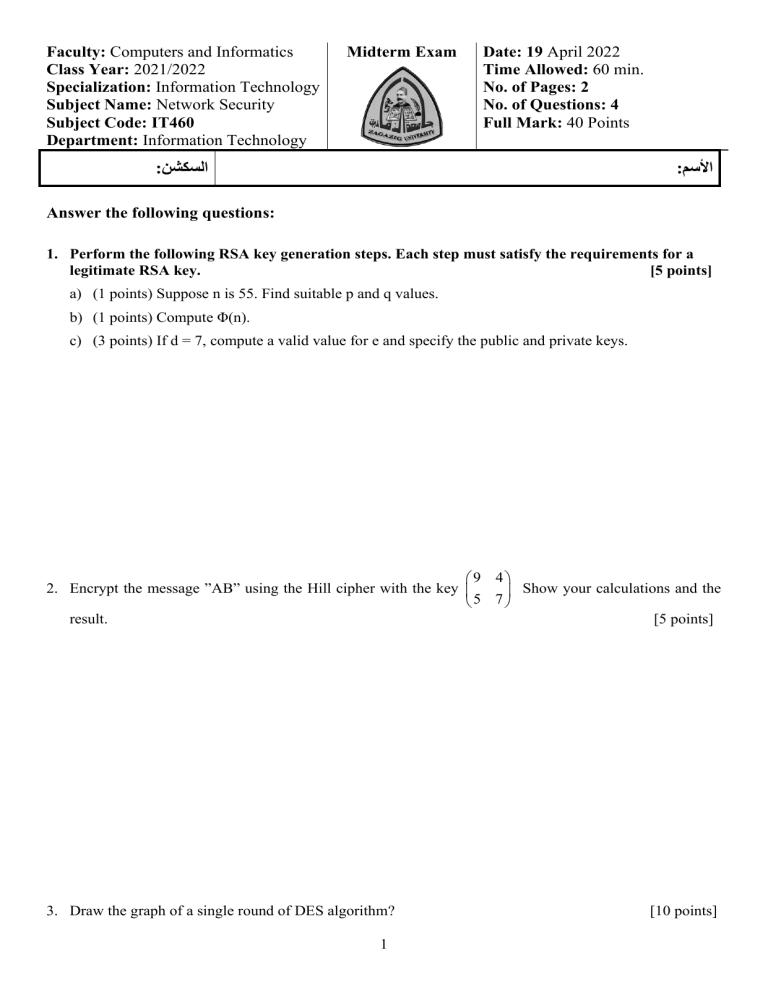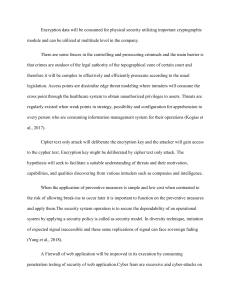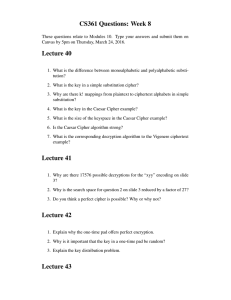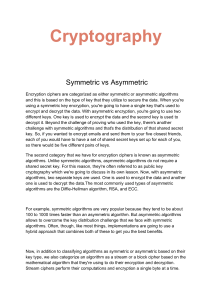
Faculty: Computers and Informatics Class Year: 2021/2022 Specialization: Information Technology Subject Name: Network Security Subject Code: IT460 Department: Information Technology Midterm Exam Date: 19 April 2022 Time Allowed: 60 min. No. of Pages: 2 No. of Questions: 4 Full Mark: 40 Points :السكشن :األسم Answer the following questions: 1. Perform the following RSA key generation steps. Each step must satisfy the requirements for a legitimate RSA key. [5 points] a) (1 points) Suppose n is 55. Find suitable p and q values. b) (1 points) Compute Φ(n). c) (3 points) If d = 7, compute a valid value for e and specify the public and private keys. 9 4 2. Encrypt the message ”AB” using the Hill cipher with the key Show your calculations and the 5 7 result. [5 points] 3. Draw the graph of a single round of DES algorithm? 1 [10 points] :السكشن :األسم 4. True or False Questions: [20 points] 1. The OSI security architecture provides a systematic framework for defining security attacks, mechanisms, and services. (T ) 2. Security attacks are classified as either passive or aggressive. (F ) 3. Authentication protocols and encryption algorithms are examples of security mechanisms. (T ) 4. The emphasis in dealing with active attacks is on prevention rather than detection. ( F) 5. The data integrity service inserts bits into gaps in a data stream to frustrate traffic analysis attempts. ( F) 6. Symmetric encryption remains by far the most widely used of the two types of encryption. ( T ) 7. With the use of symmetric encryption, the principal security problem is maintaining the secrecy of the key. ( T ) 8. Monoalphabetic ciphers are easy to break because they reflect the frequency data of the original alphabet. ( T) 9. As with Playfair, the strength of the Hill cipher is that it completely hides single letter frequencies. ( T) 10. The one-time pad has unlimited utility and is useful primarily for high-bandwidth channels requiring low security. ( F) 11. Confusion seeks to make the statistical relationship between the plaintext and ciphertext as complex as possible in order to thwart attempts to deduce the key. ( T) 12. A prime concern with DES has been its vulnerability to brute-force attack because of its relatively short key length. ( T) 13. AES uses a Feistel structure. ( F) 14. DES is a block cipher intended to replace AES for commercial applications. ( F 15. There are no practical cryptanalytic attacks on 3DES. ( T ) ) 16. It is possible to convert a block cipher into a stream cipher using cipher feedback, output feedback and counter modes. ( T ) 17. The XTS-AES mode is based on the concept of a tweakable block cipher. ( T ) 18. Asymmetric encryption utilizes only a public key for encryption and decryption. ( F ) 19. Asymmetric encryption can be used for confidentiality but not for authentication. ( F ) 20. Public-key encryption is more secure from cryptanalysis than symmetric encryption. ( Best Wishes. . . 2 F)








